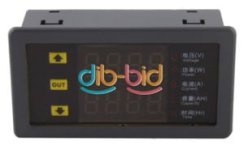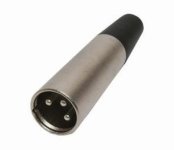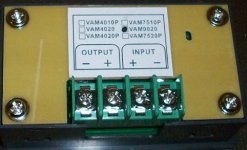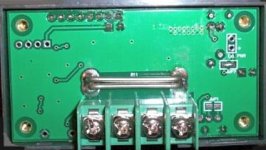jonescg
100 MW
I might put one on the race bike, with the thermocouple located at the outlet of the motor. If my Evo starts getting above 70'C, I will probably have issues. Still, 30-100'C would be more useful.
that's what i planned to do. buy 2 fets, replace the defective part, check for shorts, and then ramp up voltage from zero until something happens.fechter said:The TIP122 is rated for 100V, so should have been OK for 70V.
Either the part was defective or there may be a short on the board. I would suggest replacing it and try feeding the unit with a lower voltage from a current limited source and see if it lights up OK.
They got about 99.8% good rates. With over 10k sold. So I guess risk is quite low to receive all bad ones. And as I said if seen a lot China crap. This is one of the nicest products I've seen.SamTexas said:So instead of owning a bad one, you could possibly end up with 3 bad ones for the price of 2. Hmm...
The fourth picture in the ebay listing clearly shows 2 points labeled "Ext PWR" along with the "+" and "-" signs. So that would be where you make the connection. Obviously the external power should be ON before making the other higher voltage connection. Too simple? May be I don't understand your question/problem.izeman said:anyone? any help? thanks!
can't be. 40v must be the external supply voltage limit. that's what you use when you want to measure voltages between 0-120V. internal refers to the voltage supply on the INPUT terminals. jmho. that's what i suspect NOW. NOW, that i burnt two of them. kevin will send two new board free of charge, but i'd prefer CLEAR installation instructions. if you look at the ebay description it shows only two pictures. both have full voltage connected to the input and output terminals. external power supply solder pads (for which you have to open device) are not even mentioned. not on ebay, not in the included manual.docnjoj said:It looks to me like 40 volts is the real limit on that thing. JMHO.
otherDoc
i think you are right. one import thing to do as well is open the solder bridge. because if you don't do that, full input/output voltage will be supplied to the logic board.SamTexas said:The fourth picture in the ebay listing clearly shows 2 points labeled "Ext PWR" along with the "+" and "-" signs. So that would be where you make the connection. Obviously the external power should be ON before making the other higher voltage connection. Too simple? May be I don't understand your question/problem.izeman said:anyone? any help? thanks!
BTW, I don't have this meter so the above is what I WOULD do, not something that I have already done.


 View attachment 4
View attachment 4  &
& 
I sooo love that! There is nothing like using a bit of intuition and some resourcefulness combined with some mechanical aptitude to do something better than you could buy for hopefully a much cheaper price.ian.mich said:NeilP said:yeah, but DIY is what this forum is all about lol. Not dissing the CA but its not as cool as finding something yourself and saving some cash too
fechter said:He also lists some that are 'programmable' for under and over voltage, current, capacity, etc. that can trigger an alarm or shutoff when the limit is exceeded.
who really knows how many variants of that meter exists, and which one has which limits??friendly1uk said:Izeman, did you remove the jumper and supply the brains from a different source with success? A few pages back somebody else ran one from 12v and measured 100v.
It looks like you ordered the one that both watch's the battery charge and then gives a countdown as it discharges. I only just noticed these one's exist. It would be nice to hear how you get on
